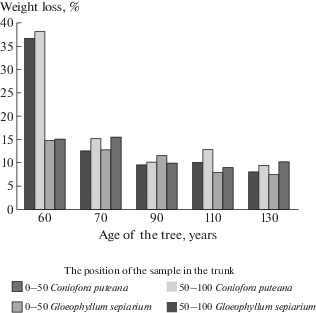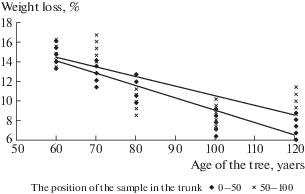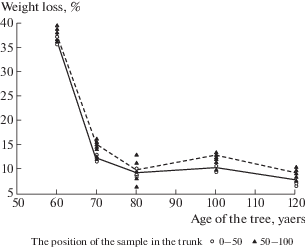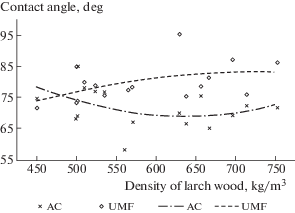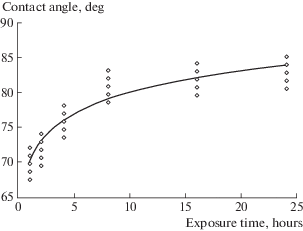Микология и фитопатология, 2019, T. 53, № 3, стр. 156-161
The decay resistance and durability of wood and wood products from larch (LARIX SIBIRICA)
V. A. Soloviev 1, M. A. Chubinsky 1, A. N. Chubinsky 1, G. S. Varankina 1, A. M. Artemenkov 1, *
1 Saint Petersburg State Forest Technical University
St. Petersburg, Russia
* E-mail: a-artemenkov@mail.ru
Поступила в редакцию 8.10.2018
После доработки 13.12.2018
Принята к публикации 24.12.2018
Аннотация
The natural resistance is determined and the kinetics of destruction of Siberian larch wood (Larix sibirica) exposed to the wood-destroying fungi Coniophora puteana and Gloeophyllum sepiarium is shown in comparison with pine wood. An assessment was made of the ability to glue veneer from Siberian larch wood. The strength of various types of structural materials from Siberian larch wood has been determined. All the studies were conducted according to well-known standard methods, taking into account the requirements of European standards. It is proved that the natural resistance of larch wood to the action of wood-destroying fungi Coniophora puteana and Gloeophyllum sepiarium is higher than that of pine wood and increases with the age of the tree. The revealed relationship between the location of a sample of wood in the trunk of a tree and its longevity is poorly expressed in comparison with the influence of age and density of wood. The use of Siberian larch wood (Larix sibirica) for the production of plywood and LVL makes it possible to obtain products with increased strength and durability. Glued structures made of Siberian larch wood are also characterized by high durability, strength and water resistance.
Larch represents the most common wood species in Russia which reserves amount to more than one third of the total volume of growing stock (about 28 out of 82 billion m3). It has a good physical and mechanical properties as well as natural decay resistance (Table 1) (Bokshchanin, 1982; Chubinsky, 1992; Poluboyarinov et al., 2000; Chubinsky, 2003; Gudaeva, 2004; Neverov et al., 2010; Belyaev, Neverov, 2011; Lavrov, Chakhov, 2014). The properties of Siberian larch wood were the subject of research by foreign scientists (Morrell, Freitag, 1995; Grabner et al., 2002; Koizumi et al., 2003; Gierlinger, Wimmer, 2004; Karlman et al., 2005; Venalainen et al., 2006; Gards, Martinsson, 2007; Martinsson, Lesinski, 2007; Halachan et al., 2017). There were made attempts to cultivate Siberian larch in Scandinavia (Martinsson, Lesinski, 2007).
Table 1.
Physical and mechanical properties of softwood
| Species | Density, kg/m3 | Compressive strength along fibers, MPа | Flexural strength, MPа | Tensile strength along fibers, MPа | Shear strength, MPа | Elastic modulus, GPа | Decay resistance (loss of wood sample mass, %, by Coniophora puteana) | |
|---|---|---|---|---|---|---|---|---|
| heartwood | sapwood | |||||||
| Larix spp. | 640 | 56.7 | 98.5 | 119.5 | 8.7 | 13.8 | – | – |
| Larix sibirica | 660 | 61.5 | 97.8 | 120.5 | 14.9 | – | 23.30 | 32.15 |
| Pinus spp. | 470 | 39.6 | 71.8 | 84.1 | 6.2 | 11.9 | – | 63.80 |
| Picea spp. | 450 | 39.0 | 70.3 | 70.3 | 6.3 | 9.3 | – | – |
| Abies spp. | 380 | 34.4 | 60.3 | 65.6 | 5.8 | 8.7 | – | – |
Main larch stand are located in Eastern Siberia and Russian Far East. Larix sibirica and L. dahurica are two main species of larch growing in Russia. Their properties are fundamentally different from those of European larch (L. decidua) in higher rates of strength and impact resistance to wood-destroying fungi (Martinsson, Lesinski, 2007). It is also known that the physical and mechanical properties of wood-based panels of larch depends on many factors (Bokshchanin, 1982; Chubinsky, 1992; Chubinsky et al., 2011; Chausov, Varankina, 2014; Lavrov, Chakhov, 2016), but durability of wood construction depends also on wood decay resistance (Martinsson, Lesinski, 2007). Main reason of the high decay resistance is large amount of wood extractives in larch wood (Chubinsky, 2003).
Despite the large reserves and high mechanical properties, larch is still not enough demand in the production of building materials and structures due to technological difficulties of its treatment. One of the most complex operations are gluing of lumber and veneer from larch wood, where traditionally used urea- and phenol-formaldehyde adhesives (Chubinsky, 1992; Chausov, Varankina, 2014). The surface of the boards of larch wood has poor ability to be wetted by adhesives due to the high content of natural resins.
Due to that, the study of the properties of larch wood and its glue ability, creating full-strength adhesive bonds with the wood is of scientific and practical interest.
MATERIALS AND METHODS
The present study was focused on the following issues: 1) the resistance of Siberian larch wood to wood-destroying fungi Coniophora puteana (Shumach.) P. Karst. and Gloeophyllum sepiarium (Wulfen) P. Karst.; 2) the decay kinetics of Siberian larch wood by Coniophora puteana and Gloeophyllum sepiarium; 3) the gluing ability of Siberian larch wood veneer from Siberian larch wood; 4) Siberian larch wood plywood and LVL strength.
The study of wood decay resistance was carried out by the standard method (GOST 28184-89 “Means of wood protection. The method of determining the limit of exposure to wood-destroying fungi Basidiomycetes class”) taking into account the requirements of European standard EN 350-1 “Durability of wood and wood-based products. Natural durability of solid wood”. Durability was evaluated by weight loss under the influence of wood-destroying fungi Coniophora puteana and Gloeophyllum sepiarium. The decomposition kinetics were investigated by the method of Chubinsky M.A. (Chubinsky, 2003). Another method was proposed by Professor V. A. Soloviev (Soloviev, Malysheva, 2004). Variables in studies of biological stability accepted age of the tree, the position of the sample in the trunk and wood density. A total of 2000 samples were tested with 20 repeats in each experiment.
The gluing ability was determined by known method (Chubinsky, 1992; Lee et al., 2007), by measuring the contact angle. Tests for strength and water resistance of the adhesive bonds were carried out by standard methods (GOST 15613.1-84 “Wood glued massive. Methods for determining the limit of the adhesive bond strength of shearing along the fiber” and GOST 9624-93, 9624-2009 “Laminated glued wood. The shearing method of determining the tensile strength”). A total of 360 samples were tested with 3 repeats in each experiment.
In studies of the gluing ability of wood a traditional domestic urea-formaldehyde and phenol-formaldehyde glue were used.
RESULTS AND DISCUSSION
The properties and structure of the wood depend essentially on the age of the tree, the place of sample situated in tree trunk, density and moisture content. The Figure 1 shows a test results of Siberian larch wood decay resistance, depending on the factors studied.
The average weight loss for the Siberian larch heartwood by exposure to Coniophora puteana was 14.84%, and Gloeophyllum sepiarium – 11.36%, which decreasing with age of the tree (Fig. 2 and Fig. 3).
A control samples of heartwood pine at age 90 years have demonstrating a weight loss in 57.8% that is significantly higher than the weight loss of larch wood. The age of the tree is one of the most important factors affecting the resistance of wood exposed to wood-destroying fungi. By increasing the age of the tree significantly increase the resistance to the destructive effects of wood-destroying fungi Coniophora puteana and Gloeophyllum sepiarium. The position of samples in the trunk of the tree is also influence by the degree of biological stability, but this dependence is expressed weakly in comparison with the influence of age and wood density.
The studies of the decay kinetics of Siberian larch wood decay (Tables 2, 3) and the role of extractives in the growth of wood-destroying fungi suggest a link to durability and content in the wood extractives, primarily alcoholic extracts.
Table 2.
Kinetics of Siberian larch wood decay by Coniophora puteana
| Duration of the experiment, day | Weight loss, % | Sample moisture content, % | Decay kinetics, k, % in days |
|---|---|---|---|
| 14 | 2.5 | 107.3 | 0.085 |
| 28 | 3.5 | 128.3 | 0.138 |
| 56 | 10.0 | 161.5 | 0.323 |
| 84 | 22.3 | 182.1 | 0.556 |
| 112 | 38.3 | 187.5 | 0.557 |
| 140 | 52.3 | 206.2 | 0.357 |
Table 3.
Kinetics of Siberian larch wood decay by Gloeophyllum sepiarium
| Duration of the experiment, day | Weight loss, % | Sample moisture content, % | Decay kinetics, k, % in days |
|---|---|---|---|
| 14 | 2.9 | 132.8 | 0.086 |
| 28 | 3.8 | 146.3 | 0.118 |
| 56 | 10.0 | 147.9 | 0.205 |
| 84 | 18.5 | 153.1 | 0.382 |
| 112 | 24.9 | 157.2 | 0.399 |
| 140 | 38.6 | 163.8 | 0.399 |
The research results also show a significantly higher moisture samples decayed by Coniophora puteana.
Availability of extractives in larch wood increasing its durability has a negative impact on the ability to interact with adhesives. Larch wood worse wetted by traditionally used in wood processing urea-melamine-formaldehyde (UMF) and phenol-formaldehyde adhesives (PF). Best result is observed while using the special adhesive composition (AC) (Figs 4, 5).
However, due to high physical and mechanical properties and the durability of larch wood, derived from it plywood, LVL have improved impact strength and resistance to wood-destroying fungi (Tables 4, 5).
Table 4.
The strength of LVL veneer thickness of 3.0 mm of Siberian larch and pine, Mpa
| Type of test | Larch | Pine |
|---|---|---|
| Tensile strength along the fiber | 80 | 65.0 |
| Bending strength perpendicular to surface of sheet | 80 | 58.0 |
| Compression strength along the fibers | 78 | 48.0 |
| Compression across the fibers: | ||
| – perpendicular surface | 13 | 8.0 |
| – parallel surface | 8 | 5.7 |
| Strength of glue bond by shearing along the fibers | 5 | 4.3 |
Table 5.
Resistance of wood materials to Coniophora puteana
| Type of material | Type of glue | Consumption of glue, g/m2 | Weight loss, % | The standard deviation of weight loss, % | The coefficient of variation, % |
|---|---|---|---|---|---|
| Larch wood lumber | – | – | 21.6 | 3.0 | 13.8 |
| Pine wood lumber | – | – | 38.0 | 4.9 | 12.8 |
| Pine plywood | Phenol-formaldehyde | 130 | 34.9 | 1.7 | 4.9 |
| Birch plywood | Phenol-formaldehyde | 120 | 43.4 | 3.5 | 8.0 |
| Pine gluelum | PVA “Kleiberit 303.0” | 140 | 28.5 | 4.3 | 15.0 |
| Pine gluelum | EPI “Prefere 6151” | 350 | 24.6 | 3.5 | 23.6 |
The shear strength of dry samples of larch plywood on urea-formaldehyde adhesives reaches (1.6–2.0) MPa, and after soaking the samples in water for a day is (1.2–1.5) Mpa that is higher than standard (GOST 3916-96 “Plywood for general purpose”). A high degree performance is achieved also by gluing of larch by veneer phenol-formaldehyde adhesives. Plywood shearing strength in dry state is in the range of (1.9–2.2) MPa and after boiling for hour is not lower than 1.3 MPa.
CONCLUSIONS
The results obtained suggest the following conclusions.
1. The larch wood (Larix sibirica) decay resistance to the attack of wood-destroying fungi Coniophora puteana and Gloeophyllum sepiarium is much higher than pine wood. Decay resistance of wood increases with its age. Position of samples in the trunk of the tree is also influenced by the degree of wood durability, but this dependence is expressed weakly in comparison with the influence of age and wood density.
2. Using of Siberian larch wood for plywood and LVL manufacturing allows to obtain the products of increased strength and durability. The strength of larch veneer LVL exceeds the strength of similar products made from pine by 1.16–1.63 times.
Список литературы
Belyaev V.V., Neverov N.A. Structure and quality of the Sukachev larch wood (Larix sukaczewii Dylis) in the Arkhangelsk region. Vestnik Pomorskogo Universiteta. Seriya estestvennye nauki. 2011. P. 34–40 (in Russ.).
Bokshchanin Yu.R. Processing and use of larch wood. Moscow, Lesnaya Promishlennost, 1982. 216 p. (in Russ.).
Chausov K.V., Varankina G.S. Investigation of the process of gluing larch wood with composite glue. Izvestia Sankt-Peterburgskoj lesotehniceskoj akademii. Saint-Petersburg State Forest Technical Academy. Saint Petersburg. 2014. N 208. P. 111–120 (in Russ.).
Chubinsky A.N. Formation of adhesive joints of wood. Saint-Petersburg State University. Saint Petersburg. 1992. 164 p. (in Russ.).
Chubinsky A.N., Fedyaev A.A., Tambi A.A. Influence of wood density on the quality of the formation of adhesive joints. Izvestia Sankt-Peterburgskoy lesotehniceskoy akademii. Saint Petersburg State Forest Technical Academy. Saint Petersburg. 2011. N 195. P. 142–149 (in Russ.).
Chubinsky M.A. Decay resistance of larch wood. Abstract of PhD dissertation. Saint Petersburg State Forest Technical Academy. Saint Petersburg. 2003. 16 p. (in Russ.).
Gards G., Martinsson O. Decay resistance in Siberian larch, Larix sibirica Ldb, heartwood. Integrated research activities for supply of improved larch to tree planting: tree improvement, floral biology and nursery production. Proceedings Saint-Michel-des-Saints and Québec City IUFRO. September 16–21. 2007. P. 83–87.
Gierlinger N., Wimmer R. Radial distribution of heartwood extractives and lignin in mature European Larch. Wood and Fiber Science. 2004. 36 (3). P. 387–394.
Grabner M., Gierlinger N., Rosner S., Wimmer R., Gindl W., Schvanninger M., Paque L. Effect of ring width of wood properties of larch. Improvement of larch (Larix sp.) for a better grows, stem form and wood quality. INRA. Unité d`Amélioration de Génétiyue et de Physiologie des Arbres forestiers. Gap-Auverge, Limousin. 2002. P. 380–387.
Gudaeva E.A. The influence of ecological and geographical growth conditions on the decay resistance and structure of the Siberian larch wood. Abstract of PhD dissertation. SibGTU. Krasnoyarsk. 2004. 28 p. (in Russ.).
Halachan P., Babiak M., Spiciak D., Chubinsky A., Tambi A., Chauzov K. Physico-acoustic characteristics of spruce and larch wood. Wood research. 2017. V. 62. (2). P. 235–242.
Karlman L., Morling T., Martinsson O. Wood density, annual ring width and latewood content in Larch and Scots Pine. Eurasian Journal of Forest Research. 2005. 8(2). P. 91–96.
Koizumi A., Takata K., Yamashita K., Nakada R. Anatomical characteristic and mechanical properties of Larix sibirica grown in South-Central Siberia. IAWA Journal. 2003. 24(4). P. 355–370.
Lavrov M.F., Chakhov D.K. Acoustic examination of larch wood. 3-ya Vserossiyskaya nauchno-prakticheskaya konferentsiya “Sovremennye problemy stroitelstva i zhizneobespecheniya”. 3–4 marta 2014. North-Eastern Federal University in Yakutsk (NEFU). Yakutsk. 2014. P. 153–154 (in Russ.).
Lavrov M.F., Chakhov D.K. Dependence of mechanical characteristics of wood on its density and macrostructure. Promyshlennoe i grazhdanskoe stroitelstvo. Industrial and Civil Engineering. 2016. N 8. P. 34–37 (in Russ.).
Lee S., Shupe T., Hse C. Wetting behaviors of phenol- and urea-formaldehyde resins as compatibilizers. Wood and Fiber Science. 2007. 39(3). P. 482–492.
Martinsson O., Lesinski J. Siberian larch forestry and timber in a Scandinavian perspective. JiLU Jamtlands Countu Council institute of Rural Development. 2007.
Morrell J.J., Freitag C.M. Durability of Dahurian larch. Forest Products Journal. 1995. V. 45. P. 77–78.
Neverov N.A., Burlakov P.S., Drovnina S.I., Khmara K.A., Belyaev V.V. Quality of Siberian larch wood in the karst landscapes of the European North of Russia. Izvestia Sankt-Peterburgskoy lesotehniceskoy akademii. Saint-Petersburg State Forest Technical Academy. Saint-Petersburg. 2010. N 193. P. 81–87 (in Russ.).
Poluboyarinov O., Chubinsky A., Martinsson O. Decay resistance of Siberian larch wood. Ambio. 2000. V. 29 (6). P. 352–353.
Soloviev V.A., Malysheva O.N. Wood-destroying capacity of fungi: determination methods, draft models and their parameters. Fungal Communities in Forest Ecosystems. Karelian Research Centre of RAS. Moscow. Petrozavodsk. 2004. V. 2. P. 197–220 (in Russ.).
Venalainen M., Harju A., Nikkanen T., Terziev N., Laakso T., Saranpaa P. Decay resistance, extractive content and water sorption capacity of Siberian larch (Larix sibirica Ledeb.) heartwood timber. Holzforschung. 2006. 60. P. 99–103.
Беляев В.В., Неверов Н.А. (Belyaev, Neverov). Строение и качество древесины лиственницы Сукачева (Larix sukaczewii Dylis) в Архангельской области // Вестник Поморского Университета. Серия: естественные науки. Архангельск. 2011. С. 34–40.
Бокщанин Ю.Р. (Bokshchanin). Обработка и применение древесины лиственницы. М.: Лесная промышленность, 1982. 216 с.
Гудаева Е.А. (Gudaeva). Влияние эколого-географических условий роста на биостойкость и строение древесины лиственницы сибирской. Автореферат дисс. … канд. сельскохозяйственных наук. Красноярск: СибГТУ. 2004. 28 с.
Лавров М.Ф., Чахов Д.К. (Lavrov, Chakhov). Акустические исследования древесины лиственницы. 3-я Всероссийская научно-практическая конференция “Современные проблемы строительства и жизнеобеспечения”. 3–4 марта 2014. Якутск: Северо-Восточный федеральный университет имени М.К. Амосова. 2014. С. 153–154.
Лавров М.Ф., Чахов Д.К. (Lavrov, Chakhov). Зависимость механических характеристик древесины от ее плотности и макроструктуры // Промышленное и гражданское строительство. 2016. № 8. С. 34–37.
Неверов Н.А., Бурлаков П.С., Дровнина С.И., Хмара К.А., Беляев В.В. (Neverov). Качество древесины лиственницы сибирской в карстовых ландшафтах Европейского Севера России // Известия Санкт-Петербургской лесотехнической академии. СПб.: СПбГЛТА. 2010. № 193. С. 81–87.
Соловьев В.А., Малышева О.Н. (Soloviev) Дереворазрушительная способность грибов: методы определения, эскизные модели и их параметры // Грибные сообщества лесных экосистем. М. Петрозаводск: Карельский научный центр РАН. 2004. Т. 2. С. 197–220.
Чаузов К.В., Варанкина Г.С. (Chausov, Varankina). Исследование процесса склеивания древесины лиственницы композиционным клеем // Известия Санкт-Петербургской лесотехнической академии. СПб.: СПбГЛТА. 2014. № 208. С. 111–120.
Чубинский А.Н. (Chubinsky). Формирование клеевых соединений древесины. СПб.: СПбГУ. 1992. 164 с.
Чубинский А.Н., Федяев А.А., Тамби А.А. (Chubinsky). Влияние плотности древесины на качество формирования клеевых соединений // Известия Санкт-Петербургской лесотехнической академии. СПб.: СПбГЛТА. 2011. № 195. С. 142–149.
Чубинский М.А. (Chubinsky). Биостойкость древесины лиственницы. Автореферат дисс. … канд. биол. наук. СПб.: СПбГЛТА. 2003. 16 с.
Дополнительные материалы отсутствуют.
Инструменты
Микология и фитопатология


